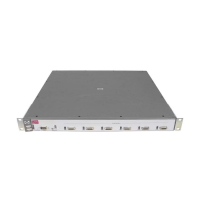Switch Meshing
Operating Notes for Switch Meshing
Operating Notes for Switch Meshing
In a switch mesh domain traffic is distributed across the available paths with
an effort to keep latency the same from path to path. The path selected at any
time for a connection between a source node and a destination node is based
on these latency and throughput cost factors:
■ Outbound queue depth, or the current outbound load factor for any given
outbound port in a possible path
■ Port speed, such as 10Mbps versus 100Mbps; full-duplex or half-duplex
■ Inbound queue depth, or how busy is a destination switch in a possible
path
■ Increased packet drops, indicating an overloaded port or switch
Paths having a lower cost will have more traffic added than those having a
higher cost. Alternate paths and cost information is discovered periodically
and communicated to the switches in the mesh domain. This information is
used to assign traffic paths between devices that are newly active on the mesh.
This means that after an assigned path between two devices has timed out,
new traffic between the same two devices may take a different path than
previously used.
To display information on the operating states of meshed ports and the
identities of adjacent meshed ports and switches, see
“Viewing Switch Mesh
Status” on page 7-14.
Flooded Traffic
Broadcast and multicast packets will always use the same path between the
source and destination edge switches unless link failures create the need to
select new paths. (Broadcast and multicast traffic entering the mesh from
different edge switches are likely to take different paths.) When an edge switch
receives a broadcast from a non-mesh port, it floods the broadcast out all its
other non-mesh ports, but sends the broadcast out only those ports in the mesh
that represent the path from that edge switch through the mesh domain. (Only
one copy of the broadcast packet gets to each edge switch for broadcast out
of its nonmeshed ports. This helps to keep the latency for these packets to
each switch as low as possible.)
7-18

